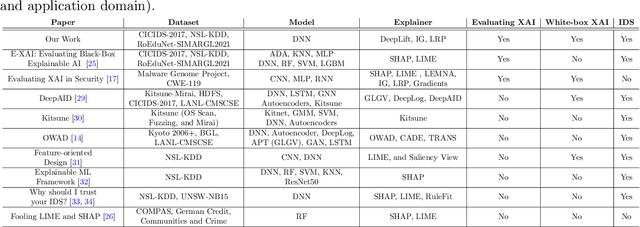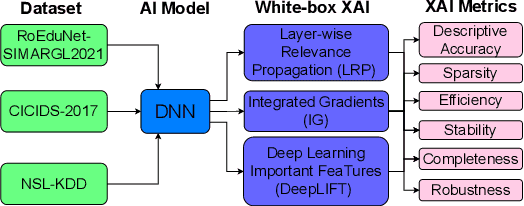Osvaldo Arreche
A Comparative Analysis of DNN-based White-Box Explainable AI Methods in Network Security
Jan 14, 2025



Abstract:New research focuses on creating artificial intelligence (AI) solutions for network intrusion detection systems (NIDS), drawing its inspiration from the ever-growing number of intrusions on networked systems, increasing its complexity and intelligibility. Hence, the use of explainable AI (XAI) techniques in real-world intrusion detection systems comes from the requirement to comprehend and elucidate black-box AI models to security analysts. In an effort to meet such requirements, this paper focuses on applying and evaluating White-Box XAI techniques (particularly LRP, IG, and DeepLift) for NIDS via an end-to-end framework for neural network models, using three widely used network intrusion datasets (NSL-KDD, CICIDS-2017, and RoEduNet-SIMARGL2021), assessing its global and local scopes, and examining six distinct assessment measures (descriptive accuracy, sparsity, stability, robustness, efficiency, and completeness). We also compare the performance of white-box XAI methods with black-box XAI methods. The results show that using White-box XAI techniques scores high in robustness and completeness, which are crucial metrics for IDS. Moreover, the source codes for the programs developed for our XAI evaluation framework are available to be improved and used by the research community.
A Comprehensive Comparative Study of Individual ML Models and Ensemble Strategies for Network Intrusion Detection Systems
Oct 21, 2024Abstract:The escalating frequency of intrusions in networked systems has spurred the exploration of new research avenues in devising artificial intelligence (AI) techniques for intrusion detection systems (IDS). Various AI techniques have been used to automate network intrusion detection tasks, yet each model possesses distinct strengths and weaknesses. Selecting the optimal model for a given dataset can pose a challenge, necessitating the exploration of ensemble methods to enhance generalization and applicability in network intrusion detection. This paper addresses this gap by conducting a comprehensive evaluation of diverse individual models and both simple and advanced ensemble methods for network IDS. We introduce an ensemble learning framework tailored for assessing individual models and ensemble methods in network intrusion detection tasks. Our framework encompasses the loading of input datasets, training of individual models and ensemble methods, and the generation of evaluation metrics. Furthermore, we incorporate all features across individual models and ensemble techniques. The study presents results for our framework, encompassing 14 methods, including various bagging, stacking, blending, and boosting techniques applied to multiple base learners such as decision trees, neural networks, and among others. We evaluate the framework using two distinct network intrusion datasets, RoEduNet-SIMARGL2021 and CICIDS-2017, each possessing unique characteristics. Additionally, we categorize AI models based on their performances on our evaluation metrics and via their confusion matrices. Our assessment demonstrates the efficacy of learning across most setups explored in this study. Furthermore, we contribute to the community by releasing our source codes, providing a foundational ensemble learning framework for network intrusion detection.
XAI-based Feature Selection for Improved Network Intrusion Detection Systems
Oct 14, 2024



Abstract:Explainability and evaluation of AI models are crucial parts of the security of modern intrusion detection systems (IDS) in the network security field, yet they are lacking. Accordingly, feature selection is essential for such parts in IDS because it identifies the most paramount features, enhancing attack detection and its description. In this work, we tackle the feature selection problem for IDS by suggesting new ways of applying eXplainable AI (XAI) methods for this problem. We identify the crucial attributes originated by distinct AI methods in tandem with the novel five attribute selection methods. We then compare many state-of-the-art feature selection strategies with our XAI-based feature selection methods, showing that most AI models perform better when using the XAI-based approach proposed in this work. By providing novel feature selection techniques and establishing the foundation for several XAI-based strategies, this research aids security analysts in the AI decision-making reasoning of IDS by providing them with a better grasp of critical intrusion traits. Furthermore, we make the source codes available so that the community may develop additional models on top of our foundational XAI-based feature selection framework.
 Add to Chrome
Add to Chrome Add to Firefox
Add to Firefox Add to Edge
Add to Edge